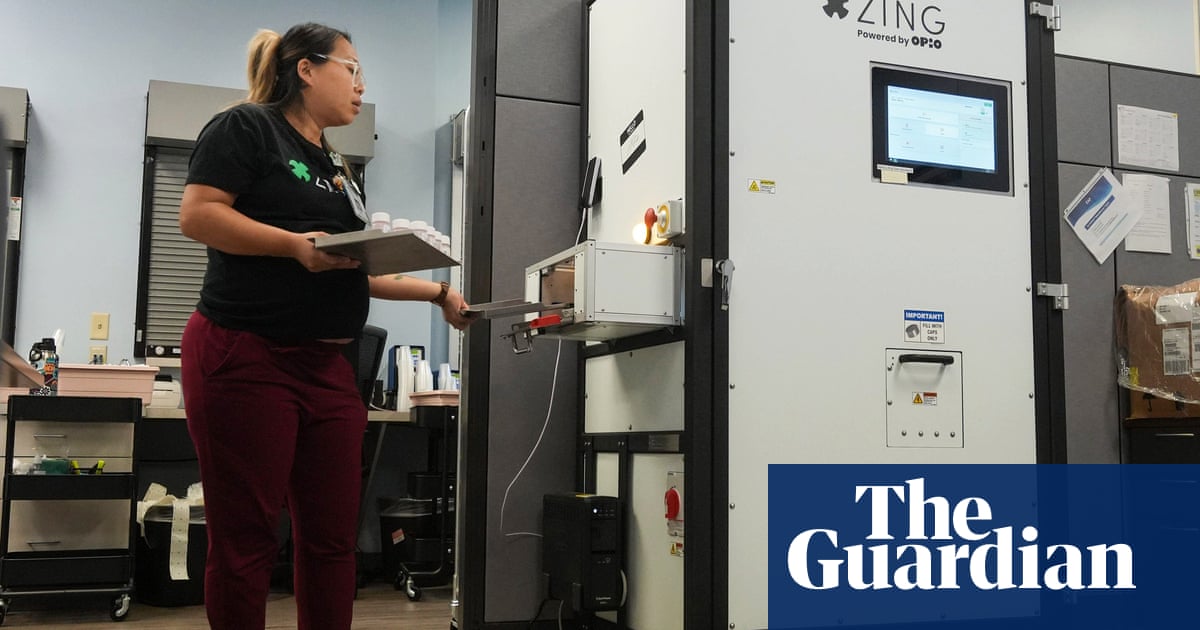Lanea George pulls open a steel security door and enters a windowless room where a video camera stares at what looks like a commercial-grade refrigerator. The machine, dubbed Bodhi, whirrs and spins before spitting out seven small plastic bottles containing precisely 70ml of methadone, a bright pink liquid resembling cherry cough syrup. It is used as a substitute for morphine or heroin in addiction treatment.
She scoops the bottles off the tray, bundles them with a rubber band and sets them on a shelf. It’s not yet 10am and George, the nurse manager at Man Alive, an opioid treatment program – known colloquially as a methadone clinic – in Baltimore, has already finished prepping the doses for the 100 or so patients who will arrive the next day. “Bodhi has changed my life and the lives of our patients,” she says.
That’s because filling the prescriptions requires more than simply pouring medicine into a bottle. It means printing out and attaching the labels one by one, precisely measuring the amounts, sealing the bottles and screwing on the caps. A spill requires the nurse to stop the work, squeegee the lost liquid into a receptacle, measure it, record the incident and destroy the sample.
Repeat that process 100 or more times, and it’s easy to see why, before Bodhi arrived, the task would have occupied a full day. The pressure to keep up causes many nurses to quit, as does the additional misery of carpal tunnel syndrome, which nurses often suffer from screwing on so many caps day after day, according to George.
“I’ve seen nurses just leave during a shift and never come back,” she says about previous clinics where she has worked.
Now, instead of pouring doses, George spends more time interacting with patients. “It lets me get more personal, have more in-depth conversations,” she says. “That’s where we get a lot of important information.”
Injecting humanity into addiction treatment
More patient interaction was the idea when Amber Norbeck came up with the idea for the machine George now uses daily. A pharmacist in the natal intensive care unit at a Montana hospital, Norbeck said so many pregnant women there struggled with opioid dependencies that as many as 50% of the newborns suffered withdrawal symptoms.
Methadone therapy helped the new mothers and moms-to-be, but access undermined their efforts; some clinics she visited had 30- to 60-day waiting lists, while at others patients faced three-hour lines despite a flock of nurses toiling at service windows. Some methadone patients are required to return to clinics daily for their doses.
“It didn’t look like healthcare, it looked like tellers in a bank pouring methadone,” Norbeck says. “For patients with kids and jobs and lives, getting the medication was so time-consuming that they’d just give up.”
As US overdose deaths from opioids rose from roughly 8,000 in 2009 to more than 114,000 in 2022, Norbeck saw a country caught between an opioid crisis and a nursing shortage. In 2019, she and Mike Pokorny, an engineer who had developed his own electric motor, began brainstorming ways to automate the assembly of methadone doses.
They devised a robotic device that could pour, seal, label and cap the liquid version of the drug – its most popular form – in seconds. A year later, Norbeck quit her job at the hospital and in January of 2021 the duo founded Opio Connect Inc, with Norbeck as CEO and Pokorny as vice-president.
They called the device they built Zing, and it came together quickly because it used parts developed for other kinds of machines. “Existing pharmacy automation solutions weren’t built to handle the kind of variability [that dispensing methadone requires],” says Sam Wilson, Opio’s COO. “So while the components of Zing existed, such as robotics, pumps, labeling tech, etc, no one had applied them to this particular challenge.”
Pandemic-era methadone rules favor automation
The creation of Zing coincided with the rise of Covid-19, which provided a boost. Pre-pandemic, patients who were considered “stable” in their treatment could receive “take-homes”, allowing them to pick up seven or even 14 doses in one visit instead of making a daily trip to the clinic. To reduce in-person contact during the shutdown, federal administrators relaxed the rules on take-homes, making them available to a wider range of patients and in batches for up to 28 days.
That policy shift led to more intensive prep and pouring for nurses, but post-Covid research showed that the change caused few problems and provided great benefits to patients, so the new take-home rules became permanent as of January 2024.
after newsletter promotion
By then, the first Zing had arrived at CompDrug, an opioid treatment program in Columbus, Ohio, complete with its own nickname: Alfie. The seven other Zings that have since come online around the country have likewise received monikers, and the humanizing effect has made them the subjects of naming votes, birthday parties, gender-reveal ceremonies and Halloween dress-up. Together, the fleet has assembled more than 1m doses of methadone.
Norbeck expects 30 to 40 more Zings to land by the end of 2025, and the company has its eyes on the 2,100 clinics around the country as well as the prisons, where, she says, “so many in the population need treatment, but they’re notoriously hard places to get nurses to work”.
Automated labor: taking jobs or ameliorating a labor shortage?
Norbeck knows of no Zing-driven layoffs, but several clinics have been able to leave open positions unfilled and direct the saved money to other treatment programs.
“There were concerns that [Zing] would take nurses’ jobs, but the real mission is to free nurses up,” says Pokorny.
CompDrug once employed six nurses to pour and distribute methadone all day. Now, three handle the task, aided by a Zing, and the other three take telehealth appointments. All six are still on staff.
At Man Alive, Bodhi’s arrival gave George enough free time that she also became the clinic’s home health nurse, helping patients connect with medical care and following up with them on medications and general healthcare issues.
Of course, there’s another side to those examples – the nurses who were not hired for open slots, telehealth roles or home health roles. Those jobs may have gone unfilled regardless of robot labor: the Health Resources and Services Administration projects a shortage of 63,720 nurses in 2030, a number that does not capture the attrition accumulated through the pandemic.
Norbeck sees her field as one in which robot labor can ease employment shortfalls rather than create them.
In Baltimore, George and Man Alive’s other nurse, Mandy Scott, have even started holding educational events in the community and attending in-house group therapy sessions to further connect with patients. Put more simply, George says, “Bodhi lets me be a nurse again.”









